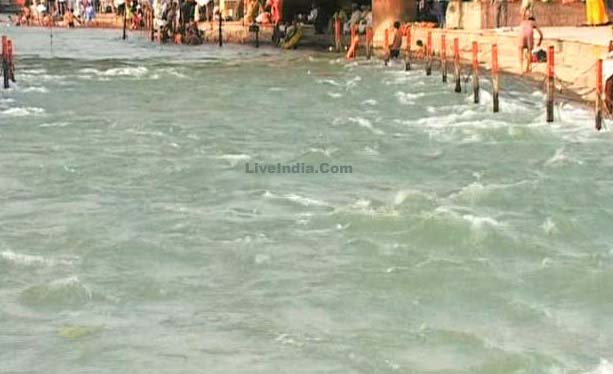The Ganges[4] (pron.: /ˈɡændʒiːz/ gan-jeez) or Ganga(IPA: [ˈɡəŋɡaː] ( listen), Sanskrit: गङ्गा, Hindi: गंगा, Bengali: গঙ্গা), is atrans-boundary river of India and Bangladesh. The 2,525 km (1,569 mi) river rises in the western Himalayas in the Indian state of Uttarakhand[4], and flows south and east through the Gangetic Plain of North India into Bangladesh, where it empties into the Bay of Bengal. It is the longest river of India and is the second greatest river in the world by water discharge.[5] The Ganges basin is the most heavily populated river basin in the world, with over 400 million people and a population density of about 1,000 inhabitants per square mile (390 /km2).[6]
listen), Sanskrit: गङ्गा, Hindi: गंगा, Bengali: গঙ্গা), is atrans-boundary river of India and Bangladesh. The 2,525 km (1,569 mi) river rises in the western Himalayas in the Indian state of Uttarakhand[4], and flows south and east through the Gangetic Plain of North India into Bangladesh, where it empties into the Bay of Bengal. It is the longest river of India and is the second greatest river in the world by water discharge.[5] The Ganges basin is the most heavily populated river basin in the world, with over 400 million people and a population density of about 1,000 inhabitants per square mile (390 /km2).[6]
The Ganges is the most sacred river to Hindus[4] and is also a lifeline to millions of Indians who live along its course and depend on it for their daily needs.[7] It is worshiped as the goddess Ganga in Hinduism.[8] It has also been important historically: many former provincial or imperial capitals (such asPatliputra,[9] Kannauj,[9] Kara, Kashi, Allahabad, Murshidabad, Munger,Baharampur, Kampilya and Kolkata) have been located on its banks.
The Ganges was ranked among the five most polluted rivers of the world in 2007,[10] with fecal coliform levels in the river near Varanasi more than one hundred times the official Indian government limits.[11] Pollution threatens not only humans, but also more than 140 fish species, 90 amphibian species and the endangered Ganges river dolphin.[10] The Ganga Action Plan, an environmental initiative to clean up the river, has been a major failure thus far,[12][13][14] due to corruption and lack of technical expertise,[15] lack of good environmental planning,[16] and lack of support from religious authorities.[17]
The Ganges begins at the confluence of the Bhagirathi and Alaknanda rivers. The Bhagirathi is considered to be the true source in Hindu culture and mythology, although the Alaknanda is longer.[18][19] The headwaters of the Alakananda are formed by snowmelt from such peaks as Nanda Devi, Trisul, and Kamet. The Bhagirathi rises at the foot of Gangotri Glacier, at Gaumukh, at an elevation of 3,892 m (12,769 ft).[20]

The Ganges is the most sacred river to Hindus[4] and is also a lifeline to millions of Indians who live along its course and depend on it for their daily needs.[7] It is worshiped as the goddess Ganga in Hinduism.[8] It has also been important historically: many former provincial or imperial capitals (such asPatliputra,[9] Kannauj,[9] Kara, Kashi, Allahabad, Murshidabad, Munger,Baharampur, Kampilya and Kolkata) have been located on its banks.
The Ganges was ranked among the five most polluted rivers of the world in 2007,[10] with fecal coliform levels in the river near Varanasi more than one hundred times the official Indian government limits.[11] Pollution threatens not only humans, but also more than 140 fish species, 90 amphibian species and the endangered Ganges river dolphin.[10] The Ganga Action Plan, an environmental initiative to clean up the river, has been a major failure thus far,[12][13][14] due to corruption and lack of technical expertise,[15] lack of good environmental planning,[16] and lack of support from religious authorities.[17]
The Ganges begins at the confluence of the Bhagirathi and Alaknanda rivers. The Bhagirathi is considered to be the true source in Hindu culture and mythology, although the Alaknanda is longer.[18][19] The headwaters of the Alakananda are formed by snowmelt from such peaks as Nanda Devi, Trisul, and Kamet. The Bhagirathi rises at the foot of Gangotri Glacier, at Gaumukh, at an elevation of 3,892 m (12,769 ft).[20]

No comments:
Post a Comment